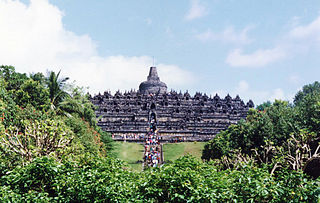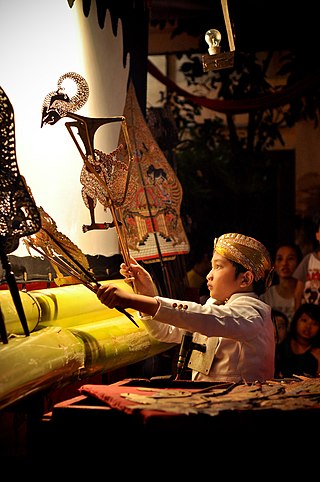
Kartavirya Arjuna was a king of an ancient Haihayas kingdom with capital at Mahishmati which is on the banks of Narmada River in the current state of Madhya Pradesh. Kartavirya was son of Kritavirya, king of the Haihayas. According to the Puranas, Haihaya was the grandson of Sahasrajit, son of Yadu(king) of Yadavas}. This is his patronymic, by which he is best known; he is also referred to simply as Arjuna. He is described as having a thousand hands and a great devotee of god Dattatreya.

Wayang is a traditional form of puppet theatre play originating from the Indonesian island of Java. Wayang refers to the entire dramatic show. Sometimes the leather puppet itself is referred to as wayang. Performances of wayang puppet theatre are accompanied by a gamelan orchestra in Java, and by gender wayang in Bali. The dramatic stories depict mythologies, such as episodes from the Hindu epics the Ramayana and the Mahabharata, as well as local adaptations of cultural legends. Traditionally, a wayang is played out in a ritualized midnight-to-dawn show by a dalang, an artist and spiritual leader; people watch the show from both sides of the screen.

Batara Kala is the god of death in traditional Javanese and Balinese mythology, ruling over it in a cave along with Setesuyara. Batara Kala is also named the creator of light and the earth. He is also the god of time, who devours unlucky people.

Anjana, also known as Anjani and Anjali, is the mother of Hanuman, one of the protagonists of the Hindu epic the Ramayana. She is said to have been a resident of Kishkindha in the text.

Bharatayuddha or Bharat Yudha is a term used in Indonesia for the Kurukshetra War, and to describe the Javanese translation and interpretation of the Mahabharata. The Mahabharata was translated into (old) Javanese under the reign of king Dharmawangsa of Medang. The current version was started by Sedah in 1157, and finished by mpu Panuluh. Mpu Panuluh also wrote the Kakawin Hariwangsa.

Wayang wong, also known as wayang orang, is a type of classical Javanese and Balinese dance theatrical performance with themes taken from episodes of the Ramayāna or Mahabharāta. Performances are stylised, reflecting Javanese court culture:
Wayang wong dance drama in the central Javanese Kraton of Yogyakarta represents the epitome of Javanese aesthetic unity. It is total theatre involving dance, drama, music, visual arts, language, and literature. A highly cultured sense of formality permeates every aspect of its presentation.
Hikayat Seri Rama is the Malay literary adaptation of the Hindu Ramayana epic in the form of a hikayat. The main story remains the same as the original Sanskrit version but some aspects of it were slightly modified to a local context such as the spelling and pronunciation of names. Numerous branch stories had also been developed as accretions to or extensions of this epic with the upgrading of minor characters to major ones, or the invention of totally new characters. For example, Malay writers and storytellers have produced variations in which Laksmana (Lakshman) plays a larger role, sometimes becoming more important than Rama the elder prince much like the Lao Phra Lak Phra Lam. Rama, although righteous and virtuous, was perceived to be weak and his character is often moved to the background while the younger Laksmana is admired for his courage and willingness to react decisively.

Semar is a character in Javanese mythology who frequently appears in wayang shadow plays. He is one of the punokawan (clowns) but is divine and very wise. He is the dhanyang of Java, and is regarded by some as the most sacred figure of the wayang set. He is said to be the god Sang Hyang Ismaya in human form.

Hyang is a representation of the supreme being, in ancient Java and Bali mythology. The spiritual entity can be either considered divine or ancestral. The reverence for this spiritual entity can be found in the folk religions of Java and Bali, such as the Sunda Wiwitan, Kejawen, Kapitayan, and Gama Tirta. The realm where Hyang resides is called the Kahyangan, which is an Old Javanese term that means "the abode of Hyang", "part of Hyang", or "heaven".

Keong Emas is a popular Javanese folklore about a princess magically transformed and contained in a golden snail shell. The folklore is a part of the popular Javanese Panji cycle, which tells stories about the prince Panji Asmoro Bangun and his consort, princess Dewi Sekartaji.
Satrio Piningit or also called Ratu Adil is a Javanese apocalyptic main character of Jongko Joyobhoyo in Javanese myths by which considered as one who would become a Great Leader of Nusantara and ruling the world from Java. In other traditions around the world, Satrio Piningit has a similar other apocalyptic characters as Messiah, Maitreya (Buddhism), or related to Imam Mahdi prophecy in Islam.

Dewi Sri or Shridevi is the Javanese, Sundanese, and Balinese Hindu Goddess of rice and fertility, still widely worshiped on the islands of Java, Bali and Lombok, Indonesia. She is often associated or equated with the Hindu goddess Lakshmi, the shakti (consort) of Vishnu.

The mythology of Indonesia is very diverse, the Indonesian people consisting of hundreds of ethnic groups, each with their own myths and legends that explain the origin of their people, the tales of their ancestors and the demons or deities in their belief systems. The tendency to syncretize by overlying older traditions with newer foreign ideas has occurred. For example, the older ancestral mythology might be merged with foreign mythology, such as Hindu, Islam, or Christian biblical mythology.

Wawacan Sulanjana is a Sundanese manuscript containing Sundanese myths. The title means "The Tale of Sulanjana", derived from the name of the hero Sulanjana as the protector of rice plant against the attack of Sapi Gumarang cow, Kalabuat and Budug Basu boars symbolizing rice pestilence. The Wawacan Sulanjana contains Sundanese local wisdom through reverence of rice cultivation in its tradition.
Medang Kamulan was a semi-mythological kingdom that is believed to be once established somewhere in Central Java according to Javanese mythology. It is either perceived as the predecessor or the actual historical kingdom of the Medang Kingdom. "Kamulan" is derived from the word "mula" in Javanese and means "origin", hence "Medang Kamulan" can be interpreted as "pre-Medang" or "Medang the origin".

Batara Guru is the name of a supreme god in Indonesian Hinduism. His name is derived from Sanskrit Bhattaraka which means “noble lord". He has been conceptualized in Southeast Asia as a kind spiritual teacher, the first of all Gurus in Indonesian Hindu texts, mirroring the guru Dakshinamurti aspect of Hindu god Shiva in the Indian subcontinent. However, Batara Guru has more aspects than the Indian Shiva, as the Indonesian Hindus blended their spirits and heroes with him. Batara Guru's wife in Southeast Asia is Shiva's consort Durga.

Petruk is a character in traditional Javanese puppetry, or wayang. He is one of the Punokawan, four comedic figures common in the medium.
Prabakusuma in the Javanese wayang is also called by the name Bambang Priyambada. He is the son of Arjuna from his marriage with Princess Dewi Supraba who became his wife when he was the king of kahyangan. Prabukusuma is as handsome and strong as his father. His accuracy in shooting an arrow is quite unbeatable. He was raised by his grandfather, Sage Sidikwaspada from Glagahwangi Monastery. Prabukusuma helped Amarta Kingdom when Princess Mustakaweni stole Jamus Kalimasada by disguising to be Ghatotkacha

Wayang kulit is a traditional form of shadow puppetry originally found in the cultures of Java and Bali in Indonesia. In a wayang kulit performance, the puppet figures are rear-projected on a taut linen screen with a coconut oil light. The dalang manipulates carved leather figures between the lamp and the screen to bring the shadows to life. The narratives of wayang kulit often have to do with the major theme of good vs. evil.














